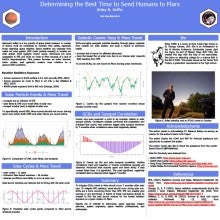Determining the Best Time to Send Humans to Mars to Avoid Space Weather
Briley
Griffin
Rock Creek High School
Poster
Crews are set to return to the Moon with Artemis II in April 2026, but the next major milestone in space exploration lies beyond the Moon: crewed missions to Mars. The environment during the journey to Mars poses significant risks to astronaut health outside of the Earth's protection. Space weather that may be encountered can be broken into two types based on whether they are created from within or outside our solar system. This poster focuses on solar storm occurrence and changes in galactic cosmic ray intensities. Understanding and forecasting when space weather hazards occur on the journey to Mars is important not only to astronauts, space agencies, mission planners, and system engineers, but is also of interest to space weather professionals, and enthusiasts. There are a number of factors to be considered when determining the impact of solar storms or cosmic rays on a Mars mission such as: intensity of radiation, spacecraft position relative to the sun, solar cycles, and the length of the events. This poster presents an overview of some of the factors that should be considered, specifically, the ones related to radiation-associated space weather events such as increased presence of cosmic rays and solar storms. Then, a more detailed examination of two factors, a spacecraft's position relative to the sun and solar cycle, is presented. Information similar to what is presented here can assist in on-going efforts to improve space weather forecast models supporting human space flight.

Poster PDF
Poster category
Solar and Interplanetary Research and Applications
Meeting homepage